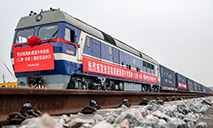Interview: HKSAR chief executive on Hong Kong's path out of worst COVID-19 wave
HONG KONG, March 9 (Xinhua) -- Chief Executive of China's Hong Kong Special Administrative Region (HKSAR) Carrie Lam on Wednesday said the HKSAR government is firmly assuming the main responsibility in fighting a war against the COVID-19 epidemic and will better leverage the resources and the central government's support.
In an exclusive interview with Xinhua, Lam said the HKSAR government aims to forge a fighting spirit and flexible strategies and make sure everyone is on the same page, noting that all the HKSAR government's over 60 departments and 180,000 civil servants should be mobilized to fight COVID-19.
Lam said the HKSAR government has taken into account the suggestions of mainland experts, who called for the anti-epidemic efforts to be currently focused on minimizing infections, severe cases, and the deaths in confirmed patients.
When infections are already widespread, the limited resources should be channelled to areas of greater need in order to ensure life and health of the Hong Kong people, especially the elderly, to be well protected from COVID-19, she said.
According to official data, as of Wednesday, the fifth wave of infections in Hong Kong has led to 2,656 deaths, and the vast majority of the deceased were the elderly whose median age was more than 80 years old. Most of them also had chronic conditions.
"Whether the old patients are at home, in an elderly care home, or already hospitalized, we need to provide them with better treatment, including both medication and personal care," Lam said.
The concentration of medical resources is also important, and similar cases should be hospitalized in designated facilities to expand the capacity of public hospitals, she said.
"Now we only have a few thousand beds for isolation treatment, and in a very short time, this number is expected to be increased to 16,000. As the total number of beds in all hospitals managed by the HKSAR Hospital Authority is more than 30,000, we will effectively allocate half of the hospital beds for COVID-19 patients," she said.
Treatment is of paramount significance so that mild COVID-19 cases will not become critical ones, Lam added.
Lam said the HKSAR government is particularly grateful for the central government's support in building community isolation facilities, which have greatly enhanced the local capacity. "There may be up to 70,000 community isolation units or beds in Hong Kong."
The second community isolation facility (CIF) in Hong Kong constructed with support from the mainland was handed over to the HKSAR government on Wednesday. The first CIF, located in Tsing Yi, started admitting its first batch of COVID-19 patients earlier this month.
"The Tsing Yi facility with 1,300 isolation units was built in seven days on a site of about 60,000 square meters. It is something Hong Kong certainly could not have done on its own," she said, adding that the HKSAR government will spare no effort to give full play to mainland-aided anti-epidemic facilities.
She said Hong Kong had weathered so many storms in the past few years and managed to get through them all with the support from the central government, and she believes that the strong support this time will further enhance Hong Kong people's centripetal forces toward the country.
"Hong Kong has emerged better and stronger from each major storm," Lam said. "This time will be no exception."
Photos
Related Stories
- Nearly 3.17 bln COVID-19 vaccine doses administered on Chinese mainland
- Daily life in Hong Kong amid COVID-19 pandemic
- Hong Kong stocks fall more than 3 pct during afternoon session
- Chinese mainland reports 233 new local COVID-19 cases
- Science, technology play crucial role in China's fight against COVID-19: minister
Copyright © 2022 People's Daily Online. All Rights Reserved.










